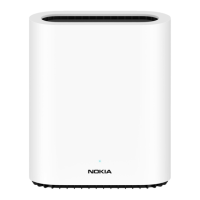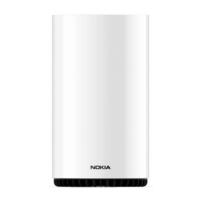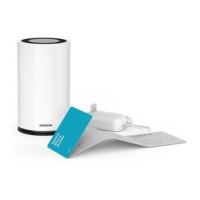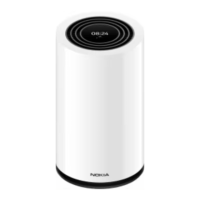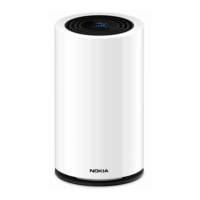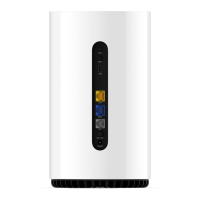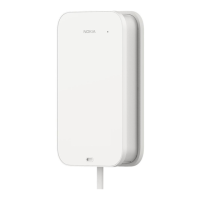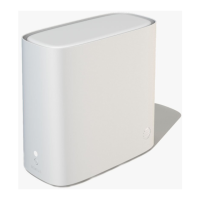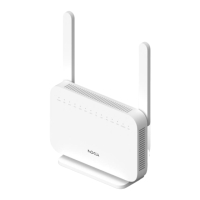Do you have a question about the Nokia FastMile and is the answer not in the manual?
Defines the purpose, scope, and intended audience of this document.
Identifies planners, administrators, operators, and maintenance personnel as the target audience.
States the need for familiarity with general telecommunications principles.
Mentions that expansions are in the glossary at the back of the document.
Provides information on obtaining technical support and ordering details.
Details compliance with TL 9000 requirements and quality practices.
Refers readers to appropriate safety guideline chapters for safety information.
Explains how to access customer documentation via ALED or OLCS.
Explains how special information (Danger, Warning, Caution) is presented in the document.
Guides users on how to search multiple PDF files using Adobe Reader.
Describes environmental instructions and labels provided with the documentation.
Explains CRoHS applicability to Electronic Information Products in China.
Mentions sample environmental labels on the equipment.
Explains the label indicating products below MCV, meaning recyclability.
Explains the label indicating products above MCV, including EFUP value.
Describes compliance with CRoHS standard and provides a link to the HST.
Outlines various environmental requirements for handling the equipment.
Refers to chapter 9 for temperature ranges and specifications.
Specifies storage requirements: weather-protected, temperature-controlled locations.
Specifies transportation requirements: packed, public transportation.
Specifies stationary use requirements: temperature-controlled location, no rain/condensation.
Details operating temperature and humidity limits for the equipment.
Explains compliance with EU RoHS Directive and Nokia's management process.
Describes requirements for collection and treatment of electronic products at end-of-life.
Refers to Chapter 10 for RF exposure information.
Describes safety instructions provided in documentation and on equipment.
Explains the use of Danger, Warning, and Caution boxes for safety instructions.
Describes safety instructions and compliance info on equipment labels.
Outlines compliance with European safety standards.
Lists the EMC requirements the equipment complies with.
Lists the equipment safety standards the unit complies with.
States compliance with EN 300019 European environmental standards.
Clarifies that the unit is not a laser product.
Provides electrical safety guidelines for the Nokia FastMile Outdoor Unit.
Warns against using non-Nokia approved power supplies, voiding warranty.
Provides guidelines for using approved and suitable cables for the equipment.
States that earthing and bonding must comply with local electrical codes.
Advises on ESD sensitivity and precautions when handling the equipment.
Refers to chapter 9 for temperature ranges and notes condensation is not an issue due to sealing.
Refers to Chapter 10 for RF exposure information.
Describes safety instructions provided in customer documentation and on the equipment.
Explains the use of Danger, Warning, and Caution boxes in documentation.
Describes safety labels on the equipment and provides examples.
Outlines compliance with North American safety standards.
Lists EMC, EMI, and ESD requirements the equipment complies with.
Lists equipment safety standards the unit complies with.
Provides electrical safety guidelines for the Nokia FastMile Outdoor Unit.
Warns against using non-Nokia approved power supplies, voiding warranty.
Provides guidelines for using approved and suitable cables for the equipment.
States that earthing and bonding must comply with NEC article 250 or local electrical codes.
Advises on ESD sensitivity and precautions when handling the equipment.
Refers to chapter 9 for temperature ranges and notes condensation is not an issue due to sealing.
Refers to Chapters 10 and 11 for RF exposure and FCC compliance.
Introduces the Nokia FastMile Outdoor Unit as an ODU for LTE broadband connectivity.
Explains the unit's role in providing LTE wireless broadband access and its features.
Mentions that variants support different E-UTRA bands for LTE.
Describes the unit's IP rating and operating temperature range.
Details the behavior of the Nokia FastMile Outdoor Unit LED indicator.
Explains how the unit receives power via Ethernet cable from indoor units or PoE injectors.
States that this section provides throughput and power consumption data.
Provides LTE throughput information for the unit.
Details the power consumption of the unit under different conditions.
Lists RF and EMC certifications for the ABA version of the unit.
Advises observing safety guidelines before installing the unit.
Lists the items included in the shipping package for the unit.
Outlines necessary knowledge, tools, and software for installation.
Provides critical lightning protection information and safety warnings.
Guides users through the installation process using the Nokia Field Assistant app.
Describes steps to be taken after the unit has been successfully installed.
Lists potential issues that may occur during installation and startup.
Addresses issues with LTE network attachment due to incorrect E-UTRA band variants.
Explains how incorrect Subscription ID can cause failure to get base station location.
Lists potential problems that can occur during the execution phase of the unit.
Discusses issues with firmware upgrades, possibly due to radio signal problems.
Explains the trace and log function for troubleshooting and root cause analysis.
Placeholder for information on factory settings, referencing another manual.
Provides key specifications for the Nokia FastMile Outdoor Unit, including dimensions, weight, and operating limits.
Discusses RF exposure assessment standards and required separation distances.
Defines the purpose, scope, and intended audience of this document.
Identifies planners, administrators, operators, and maintenance personnel as the target audience.
States the need for familiarity with general telecommunications principles.
Mentions that expansions are in the glossary at the back of the document.
Provides information on obtaining technical support and ordering details.
Details compliance with TL 9000 requirements and quality practices.
Refers readers to appropriate safety guideline chapters for safety information.
Explains how to access customer documentation via ALED or OLCS.
Explains how special information (Danger, Warning, Caution) is presented in the document.
Guides users on how to search multiple PDF files using Adobe Reader.
Describes environmental instructions and labels provided with the documentation.
Explains CRoHS applicability to Electronic Information Products in China.
Mentions sample environmental labels on the equipment.
Explains the label indicating products below MCV, meaning recyclability.
Explains the label indicating products above MCV, including EFUP value.
Describes compliance with CRoHS standard and provides a link to the HST.
Outlines various environmental requirements for handling the equipment.
Refers to chapter 9 for temperature ranges and specifications.
Specifies storage requirements: weather-protected, temperature-controlled locations.
Specifies transportation requirements: packed, public transportation.
Specifies stationary use requirements: temperature-controlled location, no rain/condensation.
Details operating temperature and humidity limits for the equipment.
Explains compliance with EU RoHS Directive and Nokia's management process.
Describes requirements for collection and treatment of electronic products at end-of-life.
Refers to Chapter 10 for RF exposure information.
Describes safety instructions provided in documentation and on equipment.
Explains the use of Danger, Warning, and Caution boxes for safety instructions.
Describes safety instructions and compliance info on equipment labels.
Outlines compliance with European safety standards.
Lists the EMC requirements the equipment complies with.
Lists the equipment safety standards the unit complies with.
States compliance with EN 300019 European environmental standards.
Clarifies that the unit is not a laser product.
Provides electrical safety guidelines for the Nokia FastMile Outdoor Unit.
Warns against using non-Nokia approved power supplies, voiding warranty.
Provides guidelines for using approved and suitable cables for the equipment.
States that earthing and bonding must comply with local electrical codes.
Advises on ESD sensitivity and precautions when handling the equipment.
Refers to chapter 9 for temperature ranges and notes condensation is not an issue due to sealing.
Refers to Chapter 10 for RF exposure information.
Describes safety instructions provided in customer documentation and on the equipment.
Explains the use of Danger, Warning, and Caution boxes in documentation.
Describes safety labels on the equipment and provides examples.
Outlines compliance with North American safety standards.
Lists EMC, EMI, and ESD requirements the equipment complies with.
Lists equipment safety standards the unit complies with.
Provides electrical safety guidelines for the Nokia FastMile Outdoor Unit.
Warns against using non-Nokia approved power supplies, voiding warranty.
Provides guidelines for using approved and suitable cables for the equipment.
States that earthing and bonding must comply with NEC article 250 or local electrical codes.
Advises on ESD sensitivity and precautions when handling the equipment.
Refers to chapter 9 for temperature ranges and notes condensation is not an issue due to sealing.
Refers to Chapters 10 and 11 for RF exposure and FCC compliance.
Introduces the Nokia FastMile Outdoor Unit as an ODU for LTE broadband connectivity.
Explains the unit's role in providing LTE wireless broadband access and its features.
Mentions that variants support different E-UTRA bands for LTE.
Describes the unit's IP rating and operating temperature range.
Details the behavior of the Nokia FastMile Outdoor Unit LED indicator.
Explains how the unit receives power via Ethernet cable from indoor units or PoE injectors.
States that this section provides throughput and power consumption data.
Provides LTE throughput information for the unit.
Details the power consumption of the unit under different conditions.
Lists RF and EMC certifications for the ABA version of the unit.
Advises observing safety guidelines before installing the unit.
Lists the items included in the shipping package for the unit.
Outlines necessary knowledge, tools, and software for installation.
Provides critical lightning protection information and safety warnings.
Guides users through the installation process using the Nokia Field Assistant app.
Describes steps to be taken after the unit has been successfully installed.
Lists potential issues that may occur during installation and startup.
Addresses issues with LTE network attachment due to incorrect E-UTRA band variants.
Explains how incorrect Subscription ID can cause failure to get base station location.
Lists potential problems that can occur during the execution phase of the unit.
Discusses issues with firmware upgrades, possibly due to radio signal problems.
Explains the trace and log function for troubleshooting and root cause analysis.
Placeholder for information on factory settings, referencing another manual.
Provides key specifications for the Nokia FastMile Outdoor Unit, including dimensions, weight, and operating limits.
Discusses RF exposure assessment standards and required separation distances.
| Category | Gateway |
|---|---|
| Technology | 4G LTE |
| Power Supply | 12 V DC |
| Weight | 500g |
| Model | FastMile |
| Wi-Fi | 802.11b/g/n |
| Ethernet Ports | 2 |
| SIM Slot | Yes |
